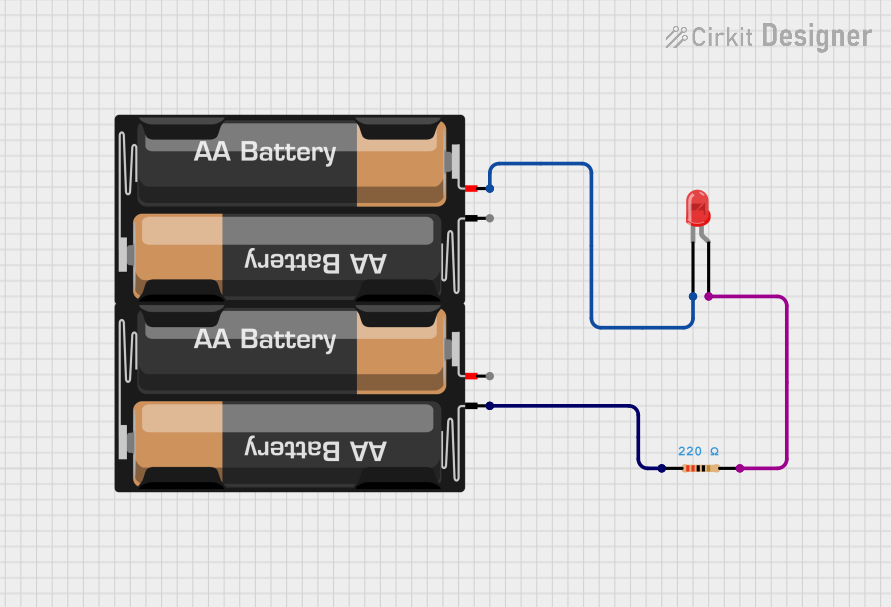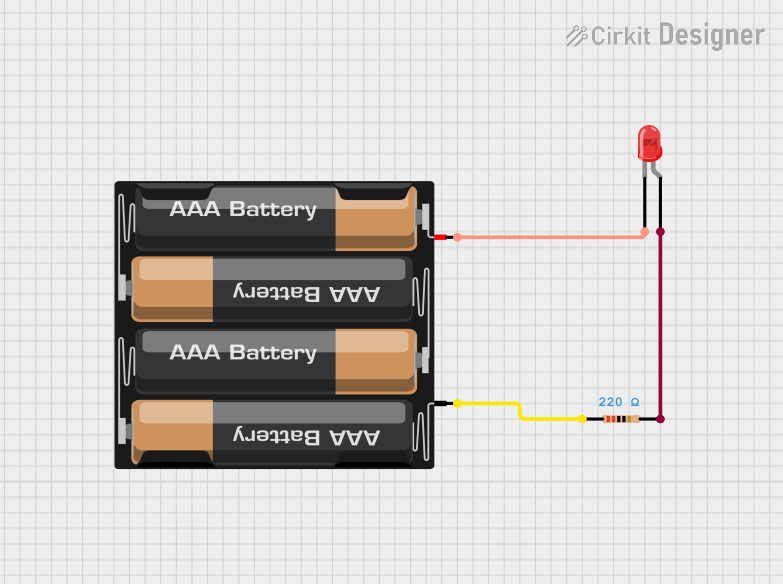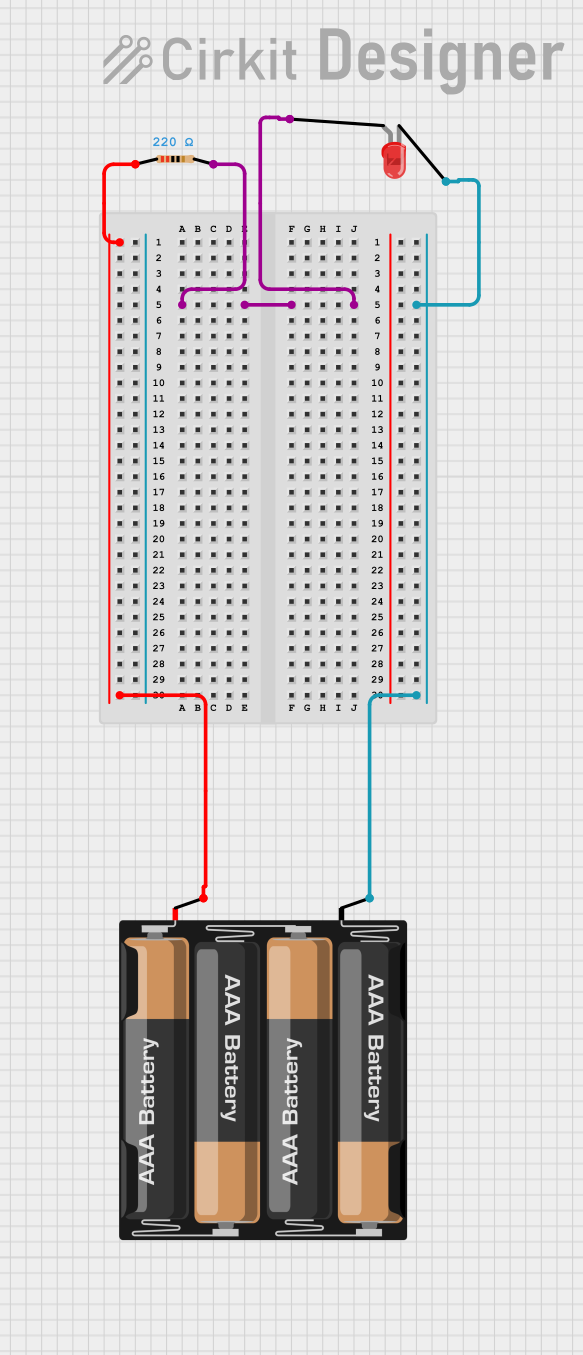
How to Use Battery AA 1.5V: Examples, Pinouts, and Specs

 Design with Battery AA 1.5V in Cirkit Designer
Design with Battery AA 1.5V in Cirkit DesignerIntroduction
The AA 1.5V battery is a single-cell, cylindrical power source widely used in a variety of portable electronic devices. Its popularity stems from its convenient size, reliable output, and availability. Common applications include remote controls, wall clocks, flashlights, and small toys.
Explore Projects Built with Battery AA 1.5V

 Open Project in Cirkit Designer
Open Project in Cirkit Designer
 Open Project in Cirkit Designer
Open Project in Cirkit Designer
 Open Project in Cirkit Designer
Open Project in Cirkit Designer
 Open Project in Cirkit Designer
Open Project in Cirkit DesignerExplore Projects Built with Battery AA 1.5V

 Open Project in Cirkit Designer
Open Project in Cirkit Designer
 Open Project in Cirkit Designer
Open Project in Cirkit Designer
 Open Project in Cirkit Designer
Open Project in Cirkit Designer
 Open Project in Cirkit Designer
Open Project in Cirkit DesignerTechnical Specifications
General Characteristics
- Nominal Voltage: 1.5V
- Chemistry: Alkaline, Lithium, NiMH rechargeable, or Zinc-Carbon
- Diameter: 14.5 mm (0.57 inches)
- Length: 50.5 mm (1.99 inches)
- Weight: Approximately 23 g (0.81 oz) for Alkaline
Electrical Specifications
| Specification | Alkaline | Lithium | NiMH | Zinc-Carbon |
|---|---|---|---|---|
| Nominal Voltage | 1.5V | 1.5V | 1.2V | 1.5V |
| Capacity | 1800-2600 mAh | 3000-3500 mAh | 1200-2700 mAh | 400-1500 mAh |
| Rechargeable | No | No | Yes | No |
Pin Configuration
As a cylindrical battery, the AA 1.5V battery does not have pins but rather terminals:
- Positive Terminal: Protruding nub at one end of the battery
- Negative Terminal: Flat opposite end of the battery
Usage Instructions
Installing the Battery
- Identify the positive (+) and negative (-) terminals of the battery.
- Align the positive terminal of the battery with the positive contact in the device.
- Insert the battery into the device, ensuring a snug fit against the contacts.
- If multiple batteries are required, ensure they are inserted in the correct orientation according to the device's instructions.
Best Practices
- Do not mix old and new batteries or batteries of different types.
- Remove batteries from the device if it will not be used for an extended period.
- Store batteries at room temperature in a dry environment.
- Do not attempt to recharge non-rechargeable batteries.
- Dispose of batteries properly, following local regulations.
Troubleshooting and FAQs
Common Issues
- Device not powering on: Check that the batteries are inserted correctly with the proper orientation. Ensure that the contacts are clean and not obstructed.
- Reduced performance: If the device is performing poorly, the batteries may be nearing the end of their life. Replace with new batteries.
- Leakage: Battery leakage can occur if batteries are left in the device for too long, especially if the device is not used. If leakage occurs, carefully remove the battery and clean the device contacts with a mild acid like vinegar, then rinse with water and dry thoroughly.
FAQs
Q: Can I use a different type of AA battery in my device? A: Yes, but be aware of the different capacities and voltage (1.2V for NiMH) which may affect device performance.
Q: How should I dispose of AA batteries? A: Dispose of batteries according to local regulations. Many areas have specific recycling programs for batteries.
Q: Are all AA batteries 1.5V? A: Most single-use AA batteries are 1.5V. Rechargeable NiMH batteries typically have a nominal voltage of 1.2V.
Q: Can I mix batteries of different chemistries in my device? A: It is not recommended to mix batteries of different chemistries due to differences in voltage and discharge rates which can affect device performance and safety.
Q: How can I tell if a battery is dead? A: The most reliable method is to use a battery tester to check the voltage. If the voltage is significantly below 1.5V (or 1.2V for NiMH), the battery is likely dead.
Connecting to an Arduino UNO
While AA batteries are not typically used to power an Arduino UNO directly, they can be used in a battery pack to provide the appropriate voltage. For example, four AA batteries in series can be used to create a 6V power supply, which can then be regulated down to 5V for the Arduino.
// No specific code is required for powering an Arduino with AA batteries.
// However, ensure that the voltage supplied to the Arduino is within its
// operating range (7-12V recommended for the VIN pin).
Remember to always check the Arduino's specifications and ensure that the power supply is within the recommended voltage range.